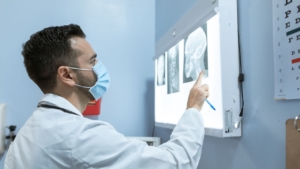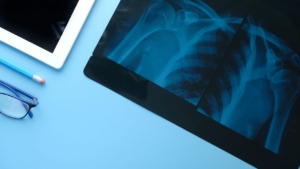Key Takeaways:
- Safety: Protect patients and healthcare workers from harmful radiation exposure.
- Compliance: Adhere to regulatory standards for radiation safety.
- Shielding Materials: Understand the options for lead, concrete, glass, and steel shielding.
- Medical Room Design: Incorporate shielding into your facility’s layout for optimal safety.
- Expert Support: Partner with a reliable medical imaging equipment distributor for guidance and compliance assistance.
In medical imaging facilities, safeguarding both patients and healthcare workers. From, Harmful radiation exposure is of utmost importance. With the increased use of advanced imaging technology. Like X-rays, CT scans, and MRIs, proper radiation shielding solutions are vital. To ensure safety and regulatory compliance. The right shielding setup not only protects against radiation hazards. But also supports the smooth functioning of your facility.
Key points to radiation shielding solutions are:
- Types of Radiations
- Design of Medical Rooms
- Regulatory Compliance
- Role of Trusted Medical Distributor
This article will provide a comprehensive guide to radiation shielding. Highlighting the importance of lead shielding design. Solutions for medical room safety. Also, Why partnering with a trusted medical imaging equipment distributor and medical imaging products supplier is key to a successful setup.
Why Radiation Shielding Is Essential
Radiation plays a crucial role in diagnostic imaging, but its exposure comes with risks if not managed properly. Ionizing radiation can be harmful to human tissue, increasing the need for appropriate safety measures. Healthcare facilities must follow strict guidelines set by regulatory bodies to minimize exposure levels. Effective radiation shielding ensures that:
- Medical personnel remain protected during imaging procedures.
- Patients receive the benefits of diagnostic imaging without unnecessary exposure.
- The surrounding environment is shielded from stray radiation.
Healthcare facilities need to prioritize shielding for specific rooms. And equipment to create a safe and efficient imaging environment.
Types of Radiation Shielding Materials
There are various materials used for radiation shielding. Each selected based on its effectiveness and application. These include:
- Lead: The most common and effective shielding material, ideal for blocking radiation in walls, doors, and windows.
- Concrete: A robust material used for structural shielding in larger facilities.
- Glass: Often lead-lined, used in observation windows to allow for monitoring without exposure.
- Steel: Occasionally used in combination with lead or concrete for additional protection.
The choice of material depends on the type of imaging equipment, room size, and regulatory requirements. Working with an experienced medical imaging products supplier ensures that. Your facility gets the right materials tailored to your needs.
Lead Shielding Design: Tailored for Safety
Lead shielding design is the cornerstone of a well-protected imaging facility. Lead is particularly effective at absorbing and blocking radiation. Making it the go-to material for shielding walls, ceilings, doors, and control room windows. Proper lead shielding design ensures that no radiation escapes from the room, keeping everyone outside safe.
Key aspects of lead shielding design include:
- Customized Thickness: The thickness of the lead material is determined based on the type and intensity of the radiation used. X-ray rooms, for instance, may require less thickness. Than a room with a CT scanner due to the differing energy levels of the equipment.
- Complete Coverage: Shielding needs to cover every surface that radiation might penetrate. This includes walls, floors, and ceilings. A well-thought-out lead shielding design will ensure no weak spots in the protection barrier.
- Door and Window Shielding: It’s not just the walls that need shielding—doors and windows are often weak points if not shielded properly. Lead-lined doors and windows offer essential protection. Allowing safe entry and monitoring without compromising safety.
Designing Medical Rooms with Safety in Mind
Medical room safety is a top priority in the layout and construction of imaging facilities. Room design must incorporate both the needs of the medical team and patient safety. Proper planning and collaboration with a medical imaging equipment distributor is critical. During the early phases of the project.
Essential Factors in Medical Room Safety Design:
- Room Layout: Imaging rooms should be designed to limit unnecessary movement of personnel and patients. This minimizes exposure time and ensures smoother workflow.
- Control Room Placement: The control room must be placed in a location. That offers direct visibility into the imaging room, protected by lead glass windows. This allows operators to safely monitor patients without radiation exposure.
- Ventilation: Proper ventilation is essential to maintain a comfortable environment. While ensuring that radiation does not travel beyond the designated space.
- Signage and Warnings: Clear warning signs must be placed outside the imaging rooms. Alerting anyone entering the presence of radiation. This is a key part of ensuring medical room safety.
By incorporating these elements. Healthcare facilities can create an efficient and safe environment for both patients and staff.
Regulatory Compliance and Best Practices
Compliance with national and local radiation safety regulations is essential. For every healthcare facility. Government bodies, such as the Nuclear Regulatory Commission (NRC) and the Environmental Protection Agency (EPA). Set stringent guidelines for radiation safety. Failing to meet these regulations can result in hefty fines and the closure of non-compliant facilities.
Working with a knowledgeable medical imaging products supplier can help ensure your facility remains compliant. They will assist with selecting the right materials. Calculating the appropriate shielding levels, and overseeing installation to meet all safety standards.
Best practices for compliance include:
- Regular inspections of radiation shielding materials.
- Continuous staff training on radiation safety.
- Using personal protective equipment (PPE), such as lead aprons and thyroid shields.
- Maintaining detailed records of safety audits and shielding inspections.
The Role of a Trusted Medical Imaging Equipment Distributor
When it comes to designing and constructing an imaging room. Partnering with an experienced medical imaging equipment distributor is invaluable. Not only do they supply the imaging machines. But they also have expertise in radiation shielding solutions. And compliance with safety regulations.
A reliable medical imaging equipment distributor offers the following benefits:
- Expert Guidance: They help determine the appropriate shielding requirements. Based on your specific equipment and room design.
- High-Quality Materials: They supply durable and compliant materials. From lead-lined drywall to lead glass windows.
- Installation Support: They work with contractors to ensure that. The shielding is properly installed and meets regulatory standards.
Similarly, a reputable medical imaging products supplier provides ongoing support. For maintenance, repairs, and replacements of critical shielding materials. Ensuring that your facility remains safe and compliant for years to come.
Regular Inspections and Upkeep of Shielding Materials
Once your facility’s radiation shielding is installed. Regular inspections and maintenance are vital. Shielding materials can degrade over time, especially in high-usage environments. Routine checks by a qualified medical imaging products supplier will catch any potential issues. Before they become safety hazards.
Inspection tasks include:
- Checking for cracks or wear in lead-lined walls.
- Ensuring doors and windows remain properly shielded.
- Verifying that control room barriers are secure and functional.
- Testing the radiation levels outside the room to ensure full containment.
Ensuring Safety with the Right Shielding Solutions
The importance of radiation shielding in medical imaging facilities cannot be overstated. It ensures the safety of both healthcare workers and patients while helping facilities remain compliant with regulatory standards. From lead shielding design to medical room safety, every step of the process requires precision and expertise.
Don’t compromise on radiation safety. Partner with Spectrum Medical Imaging Co. for expert guidance and tailored shielding solutions that protect your equipment, staff, and patients. Our commitment to quality and compliance ensures a safe and efficient imaging environment.
Ready to invest in radiation protection? Contact Spectrum Medical Imaging Co. today to discuss your needs and discover how we can help you create a safer, more compliant facility.




